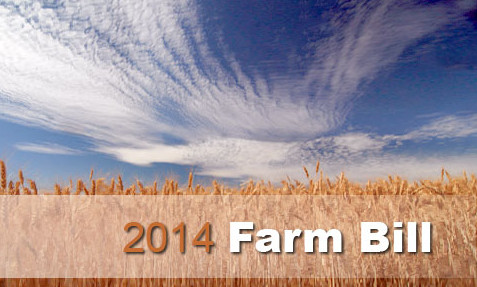Latest Farm Bill’s Effects on Landowners
 The Agricultural Act of 2014, more familiarly known as the Farm Bill, was finally passed in February, and since then the changes made in the final iteration of the bill are out in the open. Among the most significant changes for farmers and landowners—besides the end to direct payments—are the expanded insurance and revenue protection programs available. In place of DCP and ACRE programs, the new farm bill will offer:
The Agricultural Act of 2014, more familiarly known as the Farm Bill, was finally passed in February, and since then the changes made in the final iteration of the bill are out in the open. Among the most significant changes for farmers and landowners—besides the end to direct payments—are the expanded insurance and revenue protection programs available. In place of DCP and ACRE programs, the new farm bill will offer:
• Price Loss Coverage (PLC), a price protection program that triggers payments when market year average prices fall below target levels, which are called reference prices.
• Agricultural Risk Coverage County (ARC-C), a revenue protection program that triggers payments when the county revenue per acre falls below a benchmark revenue guarantee per acre set for the county.
• Agricultural Risk Coverage Individual (ARC-I), a revenue protection program that triggers payments when there is a revenue-per-acre shortfall on the individual farm that falls below a benchmark revenue guarantee per acre for that farm.
Producers taking advantage of the ARC program will have to choose either the county or farm option. The county option pays up to 85 percent of the base acres, while the farm option is limited to a maximum of 65 percent of base acres.
The PLC option will work much like the previous DCP program. The PLC payment results when the covered commodity’s marketing price falls below the reference price.
While the initial analysis of these new program options seemed a bit more clear-cut last spring, the falling grain prices and bearish markets coupled with the record volume of harvested grains forecasted this fall, the options become a bit muddied. In addition to the current market trend, it’s important for farmers and landowners to understand that whichever program in which they choose to enroll is permanent for the five year span of the bill, and cannot be changed. Therefore, it is critical that they make the best decision based on their specific farm situation.
Landowners also need to be aware that if “push-comes-to-shove” it is really the operator of record for 2014 that will make the decision. With that in mind, landowners should work with their land tenants to arrive at a decision that both parties are comfortable with. A professional land manager can provide valuable assistance to landowners when it comes to negotiating the correct programs for their land.If you are changing tenants for 2015, the former tenants have the authority to make the program decisions, when they really have no stake in the 2015 or beyond crops. This could leave the landowner, or new buyer, of the farm with a program choice they didn’t have input on. The FSA is still determining if there’ll be exceptions made for those types of situations.
Some other specific considerations to be aware of are as follows:
- Failure to enroll in 2014 places a farmer automatically in the PLC program beginning in 2015 with no payment eligibility for the 2014 crops
- If choosing either PLC or ARC-C, a farmer may enroll in different programs commodity by commodity. As an example on the same FSA farm, the corn base acreage could be enrolled in PLC while soybeans are enrolled in ARC-C
- If choosing the ARC-I program all base acres on that FSA farm must be enrolled in the ARC-I program
- Base acreage can be reallocated to be in the same proportion as the actual planted crops during the 2009 to 2012 crops. This will be an elective as each farm can stay with the current base, or update.
- Those electing PLC can update their FSA yield base to 90% of that farm’s yields from 2008 through 2012. It is likely that most electing PLC will also want to update their yields.
Undoubtedly, farmers and landowners have even more critical decisions to make with the expended program options available with the new Farm Bill. The pressure is on to have the latest information in order to make the right decision. This program details are still evolving and training for FSA staff is going on as this is written. More information will come to light in the weeks ahead.
Do you have questions or concerns about the latest Farm Bill’s affect on your land and how the programs will be applied to your property? Contact a UFARM representative, and they’ll be happy to help make you make an informed decision.
Sources consulted:
Clayton, Chris. “Offering Advice on Farm Bill Choices.” The Progressive Farmer. 12 Oct. 2014. Web. 13 Oct. 2014.
Keeney, Roman. “A Perspective on the 2014 Farm Bill.” Purdue University Center for Commercial Agriculture. Purdue University Ag Econ Dept. 2014. Web. 13 Oct. 2014.

